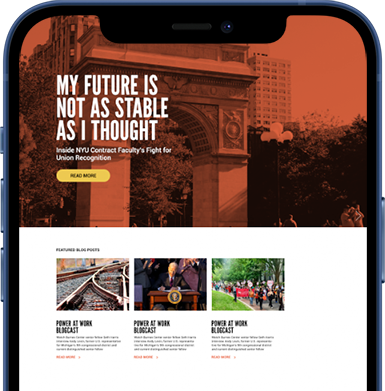"John Edwards at the WGA Picket Line", by John Edwards, CC BY-SA 2.0
This piece was originally published by Inequality.org.
Everyday we are inundated with media headlines touting AI’s potential to usher in sweeping changes to the labor market — often predicting full-scale automation and widespread job loss. However, labor has a radically different vision for the future of technology adoption, one that centers workers and communities, embraces common-sense guardrails, and enhances workers’ quality of life on and off the job.
Over the past few years, a number of different unions and worker organizations have released a series of principles, public statements, frameworks, and resolutions articulating this alternative vision. We analyzed 19 of these documents published by 17 different unions and worker organizations, and found a broad set of themes emerging — which we cover in detail in our report A First Look at Labor’s AI Values. In this piece, we lift up each of these four core themes — demonstrating that a different vision for the future of technology adoption is possible.
First, and significantly, none of the statements we examined call for an outright prohibition on using AI or other digital technologies. Instead, they lay down “rules of the road” for responsible technology adoption — a basic set of guardrails that prevent employers from engaging in some of the most harmful or dystopian practices in the workplace. Workers should have the right, for example, to ensure that important decisions about hiring, firing, and promotion are made by a human, not an algorithm. Furthermore, workers should have the right to transparency, control over their data, protection from discrimination and bias, and to a safe work environment.
Second, workers should be at the center of technology adoption. This means, first and foremost, the right to collectively bargain around if, when, and how new technologies are deployed in the workplace. It also means that workers should have the right to protect their professional judgement, be in command of the technologies they work alongside, and, crucially, be part of the design and development of the technology from the outset.
Third, for many unions and worker organizations, AI should improve rather than compromise workers’ jobs and livelihoods. This means that AI and digital technologies should assist workers in their creative work, their decision-making, or even in their collective bargaining efforts, rather than simply replace essential human tasks that society depends on. Any productivity gains should be shared with workers and the broader community.
Finally, labor is looking beyond the workplace, concerned about the role that technology is playing in society as a whole. Many organizations are calling attention to AI’s environmental impacts, its potential to exacerbate economic inequality, and the threat it poses to democratic participation and critical thinking writ large. Instead, AI should enhance equity and be used to benefit society and the public good.
While we found common themes across these documents, every organization is also responding to specific harms and impacts to their members. Education unions are concerned about the widespread imposition of generative AI products across schools and colleges in the country. Protecting worker decision-making and input is vital for healthcare organizations as algorithms threaten worker decision-making autonomy on hospital floors. Organizations representing creative workers are responding to the threat of being replaced by Generative AI systems that train on their own artistic labor. Other unions are focused on the deployment of AI in the public sector, the accelerated roll out of autonomous vehicles, or the global scope of the AI supply chain. At the same time, unions representing workers across multiple sectors are highlighting broad rights that apply to workers across the economy such as clear liability regimes, transparency, and the importance of collective bargaining.
As debates unfold about how AI could impact labor in the years to come, it is essential to pay attention to the wide range of concerns that worker organizations have about technology adoption, as well as the alternative vision they are putting forth. Ensuring responsible technology use, centering worker voice, improving jobs and livelihoods, and advancing the public good are all vital parts of this vision. Too often, technology and its impacts are seen as inevitable, but labor is insisting that the path forward is not pre-determined — workers can and should shape our collective technological future.
This work is licensed under a Creative Commons 3.0 License.

